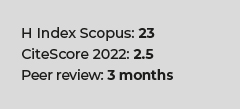Results of the epidemiological surveillance of diabetes mellitus in hospitals in Peru, 2012
DOI:
https://doi.org/10.17843/rpmesp.2014.311.2Keywords:
Diabetes mellitus, Epidemiological surveillance, Risk factors, Diabetes complications, ComorbidityAbstract
Objectives. To describe the findings of a year of epidemiological surveillance in pilot hospitals in Peru belonging to the diabetes surveillance (DS) system. Materials and methods. Cross-sectional study involving diabetic patients in the DS system from 18 hospitals during 2012. The DS database was assessed and epidemiological and laboratory variables were obtained including age, sex, type of diabetes, complications, comorbidity, microalbuminuria, fasting blood glucose and glycosylated hemoglobin (HbA1c) at two time points – at the time of enrollment and the last followup. Results. 2,959 cases were found. At the time of enrollment into the DS system, 91.2% had a fasting blood glucose test of which 65.4% had a level ≥130 mg/dL. 8.9% had a microalbuminuria test of which 20.5% had microalbuminuria and 6.5% proteinuria. In total, 1025 patients had a follow-up visit; 93.1% had a fasting blood glucose test and 22.3% had HbA1c test. 63.5% had a fasting glycemia level ≥ 130 mg/dL and 73.4% HbA1c level ≥ 7.0%. The most common complication was neuropathy (21.4 %) and the most frequent comorbidity was high blood pressure (10.5%). Tuberculosis and cancer cases were observed; the most frequent cancer was breast cancer, particularly in postmenopausal women. Conclusions. The DS shows that among diabetics of the pilot hospitals, which have laboratory results, there is a high frequency of inadequate glycemic control and poor adherence to treatment. The high frequency of complications found highlights the need to strengthen early diagnosis.Downloads
Download data is not yet available.
Downloads
Published
2014-03-14
Issue
Section
Research Articles
How to Cite
1.
Ramos W, López T, Revilla L, More L, Huamaní M, Pozo M. Results of the epidemiological surveillance of diabetes mellitus in hospitals in Peru, 2012. Rev Peru Med Exp Salud Publica [Internet]. 2014 Mar. 14 [cited 2024 Apr. 20];31(1). Available from: https://rpmesp.ins.gob.pe/index.php/rpmesp/article/view/2



























